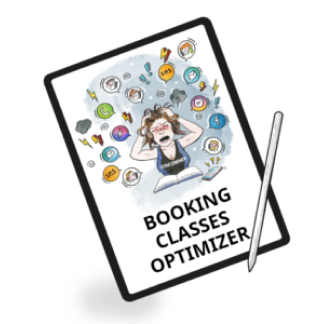The COVID-19 pandemic has accelerated the shift from offline to online in many sectors, including the fitness industry. Gyms have been particularly affected, with many having to close their doors temporarily or even permanently. However, this challenge also presents an opportunity to turn offline classes into engaging online experiences. This article will guide you through the steps to make this transition smoothly and effectively.
Why the Shift to Online Classes is Important
The shift to online classes is not just a temporary solution but a long-term strategy that can expand your customer base and increase revenue. Online classes offer convenience and flexibility, allowing people to work out from the comfort of their homes. They also enable you to reach a global audience, breaking the geographical constraints of a physical location.
Strategies to Turn Offline Classes into Engaging Online Classes
1. Choose the Right Platform
The first step in transitioning to online classes is choosing the right platform. Whether it’s Zoom, Skype, or a specialized fitness app, the platform should be user-friendly and offer high-quality video and audio. It should also have features like screen sharing and breakout rooms to facilitate different types of workouts and interactions.
2. Adapt Your Curriculum
Not all exercises and routines that work in an offline setting will translate well to an online format. You may need to adapt your curriculum to suit the limitations and advantages of online classes. For instance, focus on exercises that require minimal equipment and space, as people will be working out from home.
3. Invest in Quality Equipment
Good audio and video quality are crucial for online classes. Invest in a high-quality camera, microphone, and lighting to ensure that your classes are clear and engaging. Poor production quality can be a major turn-off and may result in losing clients.
4. Interactive Elements
One of the challenges of online classes is keeping participants engaged. Incorporate interactive elements like polls, Q&A sessions, and real-time feedback to make the classes more engaging. These features can make participants feel like they are part of a community, rather than just watching a video.
5. Offer On-Demand Content
In addition to live classes, offer on-demand content that clients can access at their convenience. This could be recorded sessions, workout plans, or even nutritional guides. On-demand content adds value to your service and provides a more comprehensive fitness solution.
6. Personalized Feedback
One advantage of offline classes is the ability to give personalized feedback. Try to replicate this in your online classes by offering one-on-one consultation sessions or using AI-powered analytics to give personalized workout recommendations. Personalized feedback can make your online classes as effective as offline ones.
7. Community Building
Create a virtual community where participants can share their progress, ask questions, and even organize virtual meetups. This can be done through a private Facebook group, a forum on your website, or a community feature in your app. A strong community can enhance engagement and customer loyalty.
8. Flexible Pricing Models
Consider offering flexible pricing models to cater to different needs. This could range from pay-per-class options to monthly subscriptions that offer unlimited access to live and on-demand content. Flexible pricing can attract a wider range of customers and increase revenue.
9. Promotion and Marketing
Don’t forget to market your online classes. Use social media, email newsletters, and partnerships with influencers to spread the word. Offer free trials or discounted rates for the first month to attract new customers.
10. Monitor and Adjust
Once your online classes are up and running, continuously monitor their performance. Use analytics to track participation rates, engagement levels, and customer feedback. Be prepared to make adjustments to your content, pricing, or marketing strategies based on these insights.
11. Leverage Social Media for Live Sessions
Utilize platforms like Instagram Live or Facebook Live for quick workout sessions or Q&A rounds. These platforms can attract potential customers who haven’t yet committed to a subscription but are interested in what you have to offer. It’s also a great way to keep your community engaged and attract a broader audience.
12. Incorporate Gamification
Gamification can add an element of fun and competition to your online classes. Use points, badges, or leaderboards to motivate participants. Challenges or milestones can also be set, with rewards for those who achieve them. This can make the online experience more interactive and engaging.
13. Multi-Level Classes
Offer classes that cater to different fitness levels. Just like in a physical gym where you have beginner, intermediate, and advanced classes, do the same for your online platform. This ensures that you cater to a broader audience and that each participant finds a class that suits their fitness level.
14. Virtual Reality (VR) Integration
If possible, integrate Virtual Reality to provide an immersive experience. VR can simulate a gym environment or even exotic locations for workouts, making the online class more exciting and engaging. However, be mindful that not all customers will have access to VR equipment.
15. Time-Zone Friendly Schedules
Since one of the advantages of online classes is the ability to reach a global audience, consider offering classes at different times to cater to various time zones. This ensures that your classes are accessible to as many people as possible, regardless of their location.
16. Regular Updates and Communication
Keep your participants in the loop with regular updates on upcoming classes, new features, or any changes in the schedule. Use email newsletters, push notifications, or social media updates for this purpose. Clear and regular communication can enhance the user experience and keep your audience engaged.
17. Offer Certificates or Achievements
At the end of a course or a significant milestone, offer certificates or achievements that participants can share on their LinkedIn profiles or social media. This not only provides a sense of accomplishment but also serves as free marketing for your online classes.
Conclusion
Transitioning from offline to online classes can be a daunting task, but with the right strategies, you can create an engaging and profitable online fitness program. By choosing the right platform, adapting your curriculum, and focusing on engagement and community building, you can turn this challenge into an opportunity for growth and expansion.


